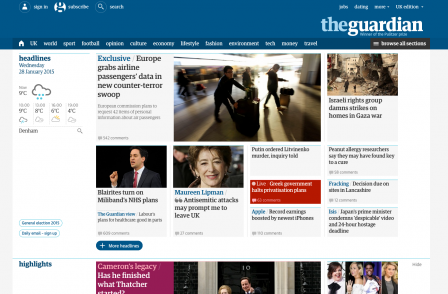
The Guardian today completes a total redesign and rebuild of its website.
The new version of the site has been available in a Beta (testing) phase for a year and the site has already been relaunched in the US and Australia.
From this morning it was due to go live for all readers of the UK version of the site.
The new site is responsively-designed meaning that it is intended to read equally well on mobiles, tablet and desktop computers. Most of The Guardian’s daily web traffic of 5.9m browsers per day (ABC) now comes from mobile.
Readers of The Guardian coming to the site from a mobile phone have up until now seen a smartphone version of the site which was launched in 2012. That site is now being switched off meaning mobile readers and desktop readers alike will seem the same version of the site.
It is the first redesign of The Guardian website since 2007 and is the culmination of an 18-month process involving up to 45 members of staff working full time.
Last May the new version of the site was made available to 5 per cent of The Guardian’s online readers in order to open up the new site to user feedback. So far Guardian director of digital strategy Wolfgang Blau says The Guardian has received some 130,000 pieces of feedback about the new look.
The process has involved a complete rebuild of the computer code that the site is built on, including new content-creation tools for journalists.
Whereas the old homepage was based on vertical columns, the new look features horizontal blocks of content divided up into: news, highlights, sport, opinion, in-depth and so on.
These blocks render as vertical columns when viewed on a mobile screen and can be inserted wholesale into story pages on the new site.
According to Blau, the new site has already led to an improvement in readers scrolling down the homepage and in the click-through rate (the number of readers who click-through to more than one story).
He also said that, unusually for a website relaunch, the new-look has not led to a discernable fall in overall traffic.
According to Blau slightly less than a third of Guardian readers come into the site via the homepage.
Blau said that one of the key requirements of the new site was to make the code which it is built on as lean as possible. He said this makes it easier for search engines such as Google to navigate and index and also makes the page loading speed faster, meaning readers are likely to look at more at pages.
Negative feedback about the new-look site includes complaints from desktop readers that there are fewer stories and pictures now on the homepage.
Blau said that there are in fact more of both, but he said that related stories, which used to appear under main stories on the Guardian homepage, have now been dropped.
New features of the site include:
- colour-coding and different page formats page for different types of content news, features, reviews, live blogs, comment
- picture galleries which open within story pages (rather than taking the reader to a different webpage)
- video can now be shared and embedded on other websites
- branded advertising content has a different font from editorially independent content
- football pages now include live blogs, previews and match reports on one page, rather having different urls.
Blau said of the new site: "It is not just about increasing size or reach, it is about deepening the relationship with viewers and readers. We want our readers to visit us more often."
He said that most newspaper website redesigns are conservative because the risks of making a mistake are too great.
He said: “The only way to mitigate that risk is to work out in the open. To interact with your readers.”
Blau said that The Guardian is competing online with new media organisations “which have no brand heritage to protect and that take huge risks”.
He said that no consideration had been given to creating a paywall for The Guardian at a future date in the rebuild. He said that digital revenue is still growing for Guardian News and Media and that the free digital journalism model still made the best business sense for the title.
Old look and new look Guardian websites:


New home-page horizontal content blocks:

New look story page

New look comment page:

Football match report page

Email pged@pressgazette.co.uk to point out mistakes, provide story tips or send in a letter for publication on our "Letters Page" blog
